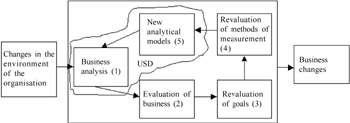Discussion and Conclusion
|
|
SP-USD is characterized by integration, interactivity and capacity of questioning. The notion of integration can be looked upon in several dimensions:
-
Aspects of ISs - integration of collecting, storing, processing, and distribution of information.
-
Roles - integration of developer, user and manager roles.
-
Roles of actors in systems development - integration of analyst, programmer, database and designer roles.
-
Integration of processing functions of the IS.
The integrated nature of USD results in interactivity. Interactivity means the UD can change quickly between developing and using the SP-UDA. During the USD-process, the UD knowledge of the business and USD increases. This is actually the goal of the UD. Since the UD knowledge of the business increases when performing USD, the UD can analyze and also question aspects of business (e.g., production measuring methods). The questioning aspect makes it possible to improve business.
SP-USD's can be used as a means of controlling continuous changes in the environment of the organization by changing business with the help of USD. A business analysis (1) can result in a revaluation of the business (2), which can result in a revaluation of its goals (3) (and norms), which can result in a revaluation of methods of measurement (4), which can result in new analytical models (5) (UDA), which can lead to a new business analysis (1) and so on. USD is discussed as one way to meet change as a permanent business condition, which differs from traditional methods for systems development.

Figure 2: Continuous Change and User Systems Development
This way of revaluating organizational goals can be related to double-loop learning as it is presented by Argyris and Schön (1996). This includes not only changes in behavior or strategies, but also means norms of the organization can be changed. The ongoing questioning of business practice performed through USD can imply this form of norm changing.
|
|
EAN: 2147483647
Pages: 186